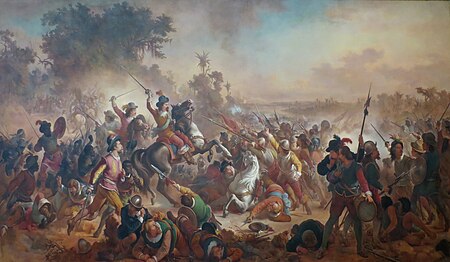| Batalha dos Guararapes | |
|---|---|
 | |
| Artist | Victor Meirelles |
| Year | 1875–1879 |
| Medium | Oil on canvas |
| Dimensions | 500 cm × 925 cm (200 in × 364 in) |
| Location | Museu Nacional de Belas Artes, Rio de Janeiro |
Batalha dos Guararapes (English: Battle of Guararapes) is an oil painting created between 1875 and 1879. It represents a history painting from the first confrontation of the Battle of Guararapes that took place in the 17th century in the Captaincy of Pernambuco, which culminated with the banishment of the Dutch invaders from Brazilian lands.[1] The canvas was painted by the Brazilian artist and professor of historical painting Victor Meirelles and the scene represents the victory of the Brazilian troops against the Dutch on April 19, 1648, in the first of the two confrontations that occurred in that battle, fought in the region of Guararapes Hill. The second confrontation would be fought months later at the same location, on February 19, 1649, leading to the definitive expulsion of the Dutch troops from the colony, which would only occur in January 1654, with the signing of their capitulation.[2]
Initially, the painting on the battle would have been assigned to the painter Pedro Américo from Paraíba, commissioned by the Minister of the Empire João Alfredo Correia de Oliveira. Once the proposal was accepted, the painter went to Italy and stayed at the Convent Santissima Annunziata, Florence to start the painting. Pedro Américo gave up painting the commissioned battle and decided to do a canvas portraying the Paraguayan War, which would be called the Battle of Avaí. With this decision, the minister transferred the commission to Victor Meirelles in 1872:[3]
Meirelles' work is one of the historical paintings that circulated most in Brazil, along with canvases such as First Mass in Brazill, also by him, and Independence or Death, by Pedro Américo. It was shown at the 25th General Exposition of the Imperial Academy of Fine Arts in 1879, in Rio de Janeiro, to some three hundred thousand visitors. There were also works by Pedro Americo in the exhibition, such as the Battle of Avaí, both representing victorious episodes in the "national military history". The exhibition, which at first highlighted the qualities of the paintings, displayed side by side, began to be marked by an atmosphere of rivalry between the authors, instigated by the opinions of the press.[4][5][3]
This battle also has the particularity of being the first moment of national communion in Brazilian history, with regard to the defense of the territory against invaders. It represents the union of the Brazilian people in favor of a national feeling. This interpretation about the Dutch invasion was built in the 19th century, based on the historiographic production of the Brazilian Historic and Geographic Institute (IHGB), creating the "visual memory of the nation". The frequent Dutch and foreign invasions in general, caused a national bond that united the three ethnic groups that formed the colony's society at the time, aligning white Europeans (Portuguese), indigenous and blacks, in a common goal: the expulsion of the Dutch not only from that region, which would later be called Northeast Brazil, but also from the whole territory of the still colony of Portugal.[6][3] It was a historically important event to portray and that would be, more than 170 years later, one of the strongest inspirations for the formation of the Brazilian Army.[7]
- ^ Cabral, Beatriz Rodrigues; Soares, Kevin Carreira (2018-12-22). "V Encontro de Jovens Investigadores em História Moderna (V EJIHM). Faculdade de Letras, Biblioteca Geral e Arquivo da Universidade de Coimbra, 30 e 31 de maio e 1 de junho de 2017". Revista de História da Sociedade e da Cultura (in Portuguese). 18: 459–460. doi:10.14195/1645-2259_18_34. ISSN 2183-8615. S2CID 198092427.
- ^ Boxer, C. R. (2004). Os holandeses no Brasil, 1624–1654 (in Portuguese) (2a ed., rev ed.). Recife: Companhia Editoria de Pernambuco. p. 339. ISBN 85-86206-18-0. OCLC 60588685.
- ^ a b c CASTRO, Isis Pimentel de; (abril de 2007). Os Pintores de História. A relação entre arte e história através das telas de batalhas de Pedro Américo e Victor Meirelles (PDF) (Tese). IFCS/UFRJ. "Domínio Público – Pesquisa Básica". www.dominiopublico.gov.br. Retrieved 2022-10-19.
- ^ Cipiniuk, Alberto (2003). A face pintada em pano de linho : moldura simbólica da identidade brasileira. Rio de Janeiro, RJ: Editora PUC-Rio. p. 42. ISBN 85-15-02721-6. OCLC 53218929.
- ^ «Victor Meirelles». Enciclopédia Itaú Cultural. Consulted in November 28, 2017.
- ^ Fernando Castilho (12 de maio de 2015). «Roberto Freire, da Cultura e Raul Jungmann, da Defesa anunciam revitalização do Parque Nacional dos Guararapes». JC Negócios. Consultado em 19 de novembro de 2017
- ^ Castro, Celso (2002). A invenção do exército brasileiro (in Brazilian Portuguese). Jorge Zahar Editor. ISBN 978-85-7110-682-6.